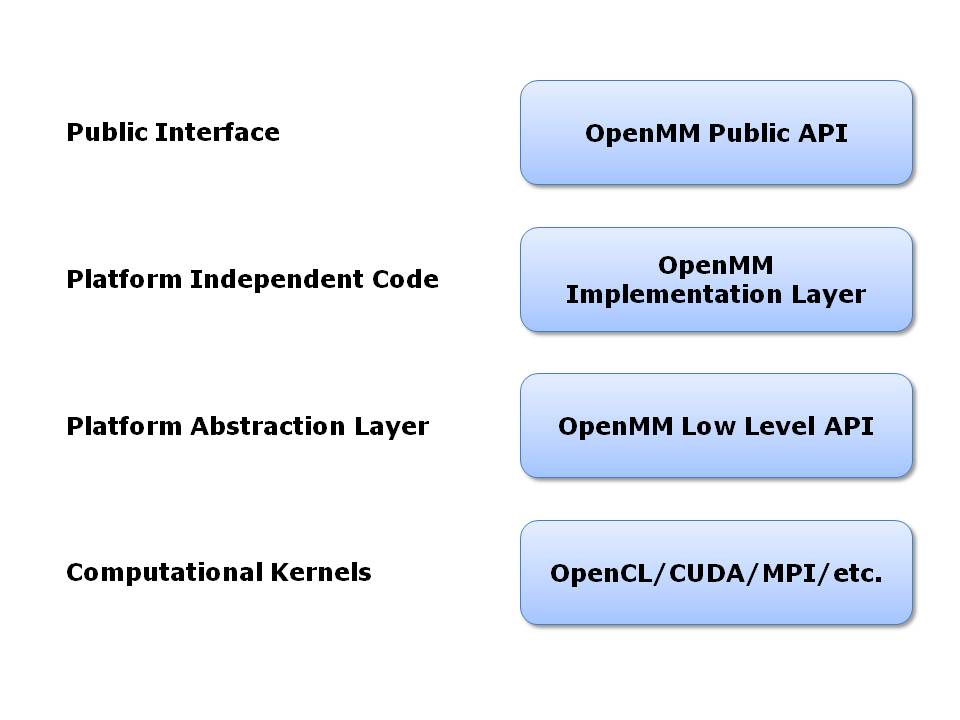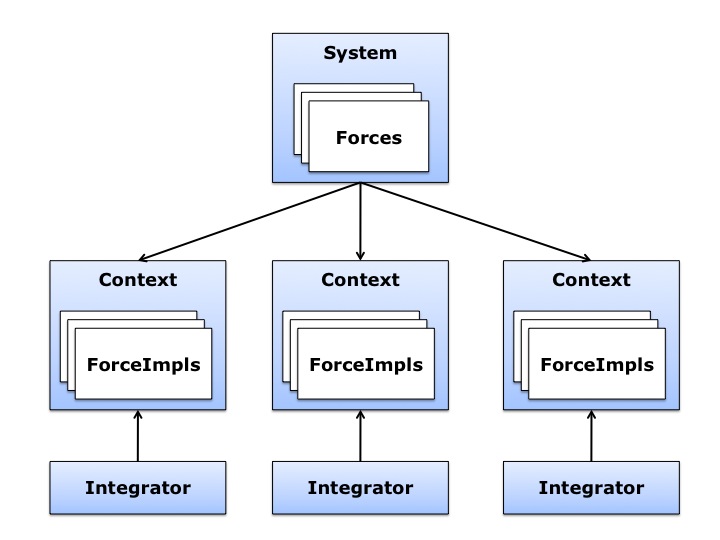2. The Core Library¶
OpenMM is based on a layered architecture, as shown in the following diagram:

Figure 2-1: OpenMM architecture¶
The public API layer consists of the classes you access when using OpenMM in an application: System; Force and its subclasses; Integrator and its subclasses; and Context. These classes define a public interface but do no computation.
The next layer down consists of “implementation” classes that mirror the public API classes: ContextImpl, ForceImpl, and a subclass of ForceImpl for each subclass of Force (HarmonicBondForceImpl, NonbondedForceImpl, etc.). These objects are created automatically when you create a Context. They store information related to a particular simulation, and define methods for performing calculations.
Note that, whereas a Force is logically “part of” a System, a ForceImpl is logically “part of” a Context. (See Figure 2-2.) If you create many Contexts for simulating the same System, there is still only one System and only one copy of each Force in it. But there will be separate ForceImpls for each Context, and those ForceImpls store information related to their particular Contexts.

Figure 2-2: Relationships between public API and implementation layer objects¶
Also note that there is no “IntegratorImpl” class, because it is not needed. Integrator is already specific to one Context. Many Contexts can all simulate the same System, but each of them must have its own Integrator, so information specific to one simulation can be stored directly in the Integrator.
The next layer down is the OpenMM Low Level API (OLLA). The important classes in this layer are: Platform; Kernel; KernelImpl and its subclasses; and KernelFactory. A Kernel is just a reference counted pointer to a KernelImpl; the real work is done by KernelImpl objects (or more precisely, by instances of its subclasses). A KernelFactory creates KernelImpl objects, and a Platform ties together a set of KernelFactories, as well as defining information that applies generally to performing computations with that Platform.
All of these classes (except Kernel) are abstract. A particular Platform provides concrete subclasses of all of them. For example, the reference platform defines a Platform subclass called ReferencePlatform, a KernelFactory subclass called ReferenceKernelFactory, and a concrete subclass of each abstract KernelImpl type: ReferenceCalcNonbondedForceKernel extends CalcNonbondedForceKernel (which in turn extends KernelImpl), ReferenceIntegrateVerletStepKernel extends IntegrateVerletStepKernel, and so on.
We can understand this better by walking through the entire sequence of events that takes place when you create a Context. As an example, suppose you create a System; add a NonbondedForce to it; create a VerletIntegrator; and then create a Context for them using the reference Platform. Here is what happens.
The Context constructor creates a ContextImpl.
The ContextImpl calls
createImpl()on each Force in the System, which creates an instance of the appropriate ForceImpl subclass.The ContextImpl calls
contextCreated()on the Platform(), which in turn callssetPlatformData()on the ContextImpl. This allows Platform-specific information to be stored in a ContextImpl. Every Platform has its own mechanism for storing particle masses, constraint definitions, particle positions, and so on. ContextImpl therefore allows the Platform to create an arbitrary block of data and store it where it can be accessed by that Platform’s kernels.The ContextImpl calls
createKernel()on the Platform several times to get instances of various kernels that it needs: CalcKineticEnergyKernel, ApplyConstraintsKernel, etc.For each kernel, the Platform looks up which KernelFactory has been registered for that particular kernel. In this case, it will be a ReferenceKernelFactory.
It calls
createKernelImpl()on the KernelFactory, which creates and returns an instance of an appropriate KernelImpl subclass: ReferenceCalcKineticEnergyKernel, ReferenceApplyConstraintsKernel, etc.
The ContextImpl loops over all of its ForceImpls and calls
initialize()on each one.Each ForceImpl asks the Platform to create whatever kernels it needs. In this example, NonbondedForceImpl will request a CalcNonbondedForceKernel, and get back a ReferenceCalcNonbondedForceKernel.
The ContextImpl calls
initialize()on the Integrator which, like the other objects, requests kernels from the Platform. In this example, VerletIntegrator requests an IntegrateVerletStepKernel and gets back a ReferenceIntegrateVerletStepKernel.
At this point, the Context is fully initialized and ready for doing computation. Reference implementations of various KernelImpls have been created, but they are always referenced through abstract superclasses. Similarly, data structures specific to the reference Platform have been created and stored in the ContextImpl, but the format and content of these structures is opaque to the ContextImpl. Whenever it needs to access them (for example, to get or set particle positions), it does so through a kernel (UpdateStateDataKernel in this case).
Now suppose that you call step() on the VerletIntegrator. Here is
what happens to execute each time step.
The VerletIntegrator calls
updateContextState()on the ContextImpl. This gives each Force an opportunity to modify the state of the Context at the start of each time step.The ContextImpl loops over its ForceImpls and calls
updateContextState()on each one. In this case, our only ForceImpl is a NonbondedForceImpl, which returns without doing anything. On the other hand, if we had an AndersenThermostat in our System, its ForceImpl would invoke a kernel to modify particle velocities.
The VerletIntegrator calls
calcForcesAndEnergy()on the ContextImpl to request that the forces be computed.The ContextImpl calls
beginComputation()on its CalcForcesAndEnergyKernel. This initializes all the forces to zero and does any other initialization the Platform requires before forces can be computed. For example, some Platforms construct their nonbonded neighbor lists at this point.The ContextImpl loops over its ForceImpls and calls
calcForcesAndEnergy()on each one. In this case, we have a NonbondedForceImpl which invokes its CalcNonbondedForceKernel to compute forces.Finally, the ContextImpl calls
finishComputation()on its CalcForcesAndEnergyKernel. This does any additional work needed to determine the final forces, such as summing the values from intermediate buffers.
Finally, the VerletIntegrator invokes its IntegrateVerletStepKernel. This takes the forces, positions, and velocities that are stored in a Platform- specific format in the ContextImpl, uses them to compute new positions and velocities, and stores them in the ContextImpl.
